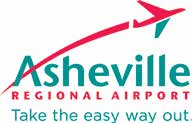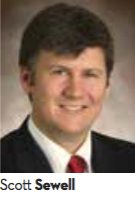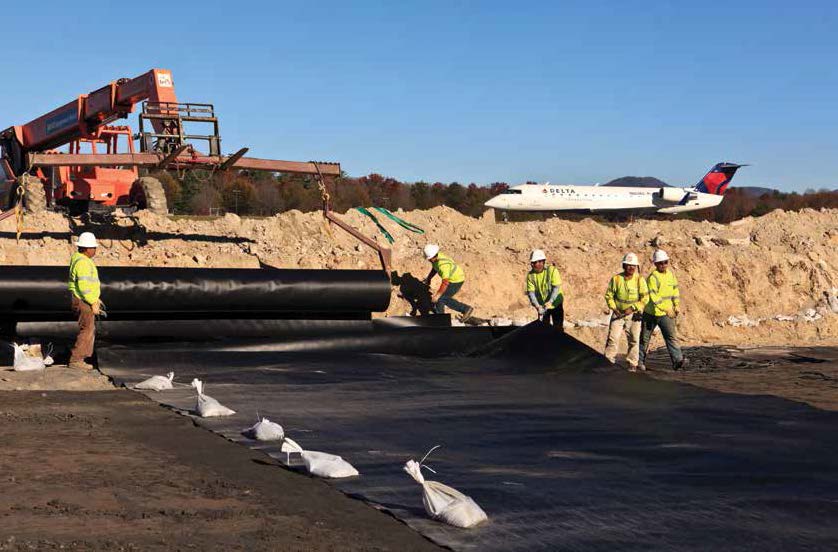When it came time for Asheville Regional Airport (AVL) to reconstruct its only runway, the management team got creative. Instead of resigning to an extended shutdown that would have effectively put the North Carolina airport out of business for an extensive period, they decided to build a new taxiway and use it as a temporary runway while the existing runway is demolished and reconstructed.
But that’s only the beginning of their story.
“We’re located in a mountainous area,” explains Mike Reisman, AVL’s deputy director of development and operations. And as such, most of the airport’s land outside of the runway and taxiway safety areas is greatly varied in topography. To build, we needed to reclaim land that in some areas was 40 to 60 feet below the airfield elevation.”
Enter Progress Energy (which has since merged into Duke Energy) and Charah, a construction company that specializes in coal ash management. AVL partnered with the two firms and initiated work in 2009 on a massive reclamation project that spans more than 50 acres and uses coal ash fill to build previously unusable land up to airfield level grade.
While a large portion of the reclaimed land is designated for business development, AVL’s new taxiway/temporary runway is being built on a portion of the most recent 30-acre reclamation site.

facts figuresProject: Land Reclamation Location: Asheville (NC) Regional Airport Acres Reclaimed: 50 Fill Material Used: Coal ash from nearby energy plant General Contractor: Charah Coal Ash Supplier: Duke Energy Construction Management: Avcon Liner System: Chesapeake Containment Systems Construction Timeline: Nov. 2009 – Fall 2015 Honors: 2011 General Aviation Project of the Year, awarded by the Southeast Chapter of the American Association of Airport Executives Of Note: Using a local byproduct rather than tradition fill saved the airport about $12 million |
Lew Bleiweis, the airport’s executive director, describes the fortuitous and mutually beneficial arrangement: “The energy company needed a safe storage solution for their coal combustion byproduct, known as coal ash; and the airport needed fill material suitable for the airfield project. It was a win-win situation.”
Even the geography was right. “They were able to safely place coal ash in an area only a couple of miles from their coal ash storage ponds,” Bleiweis continues.
In the end, using Duke Energy’s byproduct saved AVL approximately $12 million in land reclamation costs over traditional methods, and about 4 million cubic yards of coal ash found a new home, he relates.
Reclaiming Land
Charah initiated work on the 53-acre Westside Project by completing an environmental assessment and due diligence audit. Borings were taken to determine the geologic and hydrogeologic conditions. And erosion, sediment and pollution prevention controls were implemented according to local, state and federal regulations regarding coal ash as fill.
Although state regulations did not require a liner system for the project, AVL, Charah and Duke Energy determined that installing a state-of-the-art liner system with an estimated 400-year life expectancy was a more environmentally responsible approach, Reisman explains.
Construction began by clearing, grubbing and excavating existing soils to establish a suitable subgrade surface. A geocomposite clay bottom liner, 60-mil high-density polyethylene bottom liner and geocomposite drainage liner were then laid over the subgrade surface. Above the liners, Charah installed perforated drainage collection piping and wash stone wrapped with nonwoven geotextile to capture and disperse residual drainage from the coal ash.
“The coal ash is encapsulated within a fully sealed vessel,” Reisman elaborates. “After they clear the ground area, they place the geocomposite clay liner directly on the ground. This liner consists of two layers of nonwoven geotextiles containing bentonite to serve as a barrier between the ground and coal ash. A thick, semi-rigid 60-mil synthetic liner is then laid out in large rolls, and seams are overlapped and heat welded. Next, a drainage liner is set in place to capture moisture retained in the coal ash and disperse it to either an underground holding chamber or the sanitary sewer system.”
Charah excavated and stockpiled coal ash from Duke Energy’s coal ash ponds. After the ash was dry enough, it was loaded onto dump trucks and hauled to the fill site. “A 15% to 25% moisture level is optimum for compaction and dust control,” informs Scott Sewell, Charah’s chief operations officer.

Contrary to what some might assume, Sewell says that coal ash packs like concrete. “It’s some of the best material we’ve ever worked with as far as uniformity of size and compaction,” he reports.
Crews laid the coal ash in approximately 12-inch lifts, then spread and compacted it with a vibrating smooth drum roller to achieve the FAA compaction requirement of 95% Proctor. Both nuclear and standard density testing methods were used to confirm the compaction, notes Sewell. When elevation reached within 6 feet of final grade elevation, workers laid a 30-mil high-density polyethylene cap liner over the top of the coal ash and heat welded around the perimeter to the bottom 60-mil liner, creating a fully sealed vessel, he explains. To bring the fill to final grade, 6 feet of soil topped with vegetative cover was placed and compacted per FAA requirements.
Before the current fill project began, AVL completed a smaller fill project on the north general aviation side of the airport that also used coal ash as fill. The earlier project added approximately 15 acres of land suitable for aeronautical use and required mitigation efforts due to environmentally sensitive areas, including a stream and wetlands.
The airport selected Avcon to provide construction management services for the current project. “Approximately 1,100 linear feet of 60-inch reinforced concrete pipe was installed about 40 feet below the finished grade,” explains Mike Darcangelo, Avcon’s regional manager. “The pipe carries stormwater, and is in place to manage the required removal and mitigation of a small stream.

“Also, per regulations, Charah constructed a 50-foot buffer on each side of the pipe to keep the former streambed area free from the coal ash fill. Only an earth fill and 6-foot soil cap could be placed above and around the pipe.”
Looking Forward
With the current fill project projected to be complete by September, AVL broke ground last August on its $64 million taxiway and runway project. According to Bleiweis, the new taxiway/temporary runway is expected to take two years to complete, and the new runway an additional two years.
“It’s all part of the airport’s 20-year master plan,” he remarks. “Once the temporary runway is commissioned as our main runway, we will begin work on the new permanent runway.”

None of the improvements would have been possible without the reclamation of nearby land, he adds.
“It’s been a great partnership,” Bleiweis reflects. “The energy company had a byproduct they needed to safely store, and we had an area that needed to be filled. Plus, in effect, this has been a green project – not just because we are recycling coal ash materials, but because the coal ash was relocated so close to the airport. That translates into less fuel and exhaust pollution throughout the duration of the project.”
Garry Whisnant, plant manager at Duke Energy’s Asheville facility, feels similarly about the project. “Our partnership with the airport has allowed us to reuse ash in a beneficial way and help advance the airport’s comprehensive growth plans,” says Whisnant. “This project is a perfect example of how innovative solutions can drive economic development in local communities. We are excited to be part of it and hope to find similar opportunities in other communities as well.”


| Free Fill Adds Land, Saves $15 Million at Lewis University Airport
Starting in 2001, Lewis University Airport (LOT) in Romeoville, IL, began periodically receiving loads of coal combustion byproducts from several nearby energy plants. The process continued off and on for seven years, and work crews following plans created by Hanson Professional Services transformed the small airport’s landscape, using the coal ash to create a base for a new runway. When the dump trucks began making their treks, LOT had a single 2,900-foot runway set on 172 acres of land. Today, it boasts a 6,500-foot instrument-equipped runway designed to handle corporate aircraft plus a 5,700-foot crosswind runway on 1,000 acres of land. Chris Lawson, director of aviation at LOT, describes the project as an ingenious and cooperative effort. “The Illinois Division of Aeronautics and the FAA saw $15 million of savings in construction costs,” Lawson notes. Approximately 2 million cubic yards of fly ash and bottom ash were placed on airport land, plus an additional 500,000 cubic yards of onsite clay for the top, bottom and sides of the fill area, reports Ron Hudson, Hanson’s project manager. The coal combustion byproduct fill was placed and compacted in 8-inch lifts to build a 35-foot embankment to support the new runway, explains Hudson. The design included an engineered clay liner with a composite geo-membrane as well as a leachate collection layer and piping system. The material was fully encapsulated with another geo-membrane, he adds. An additional drainage layer with underground piping carries groundwater away from pavements. Clay and topsoil were laid and compacted above the geo-membrane fabric. The areas excavated onsite became the project’s storm water detention areas, which saved additional dollars. “Five years after construction, the site and runway are still in great shape,” reports Hudson. “Because of this success, the public-private partnership remains in place, with a smaller scale embankment program designed to create an extended runway safety area at the airport in the works.” |




